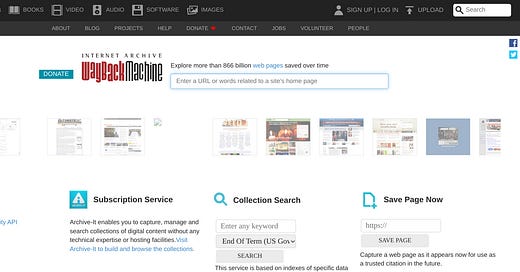How to Time Travel With the Wayback Machine
Rediscover long lost information with the Internet Archive
Have you ever come across a webpage that no longer exists and wished you could go back in time to see it as it once was? You’re in luck! We can time travel. Really!
The Wayback Machine, now known as The Internet Archive, is a 501(c)(3) non-profit that is archiving digital content around the globe. It began in 1996 by archiving the early days of the internet and now has more than 28 years of web history. It also works with more than 1,200 libraries and other partners to identify important web pages through its Archive-It program. Today, the archive contains:
835 billion web pages
44 million books and texts
15 million audio recordings (including 255,000 live concerts)
10.6 million videos (including 2.6 million Television News programs)
4.8 million images
1 million software programs
How to view a webpage that no longer exists
Genealogists have used the internet since its infancy to find and publish family history details. Unfortunately, some of those websites have disappeared over the years. Rootsweb is a big one that comes to mind. Rootsweb had incredible mailing lists that were location-specific and served as an early iteration of message boards and Facebook groups. I remember signing up for the Floyd County, Virginia Rootsweb list and loving the collaboration among family historians.
So, how do you view a webpage that no longer exists? It sounds like magic, right? But with the Wayback Machine, it’s possible!
Let’s start with the Rootsweb example. I had a particular thread bookmarked a while back, but when I go to it now, I get an error message: “Something isn't right here. We've encountered a 404 Error.” But, they offer a link to their archived site. “If you are looking for a Rootsweb Mailing Lists, you can search the Mailing List Archives (available on the Internet Archive).
You can use this page to search their archives.
Another website that I frequently used in the early days of my genealogy research was created by my late, dear friend Paul Collins. “Ole Paul’s Photo Album” is a treasure trove of photographs for families of Floyd County, Virginia. In addition to photos from his personal collection, Paul gathered photos from fellow genealogy enthusiasts with roots in Floyd County. Even though the website is no longer active, you can use the Internet Archive Wayback Machine to view it!
Tip: Use the Wayback Machine timeline at the top of the page to view a website at different points in time, with different content. Paul’s website was “captured” at various times between 2003 and 2015.
How to archive webpages for the future
If you find a helpful webpage and want to make sure you can access it in the future, you can archive it using the Internet Archive! Why is this important?
Last month, Paramount Global shut down the news archives of its MTV and CMT entertainment websites. Not only did we lose decades of music history through artist interviews and news articles, but the music journalists who wrote those stories lost the history of their hard work. But thanks to the Wayback Machine, people can access MTV News archives here and view the CMT News archives here.
So, let’s archive a webpage! I’ll use my recent interview with Clay Walker for Music Mayhem Magazine as an example.
On the Wayback Machine homepage, enter the URL of the webpage you wish to save under “Save Page Now.” You don’t need an account to do this, but you’ll have extra options if you sign in.
After you “Save Page,” it will take a minute or so to capture the content. And that’s it! The webpage will refresh to let you know when it’s complete. You’ve helped archive the internet!
Bon voyage on your time travel adventures!











I absolutely LOVE the Internet Archive! It's definitely important that more genealogists learn about it and it's features. I teach on it any opportunity I get and thank you for writing an excellent blog post on it!!